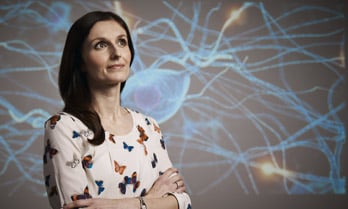







30 November 2021
2021 FELLOW DR PIP KAROLY, The University of Melbourne and Seer Medical
Wearables have become the norm for tracking our physical activity and performance, but now there is the next generation of sophisticated wearable devices being created. These devices could hold the answer to tracking the cyclic behaviour of disease or disorders.
Similar to how a circadian rhythm follows cyclic biological changes within our body over a 24 hour cycle, it is now believed diseases and conditions such as epilepsy also follow cycles that we could track and provide vital forecasting of episodes
For individuals that suffer from epilepsy, with unpredictable seizures – it can be challenging for some to go about their everyday activities. Seizures interrupt healthy brain function and can lead to loss of bodily control, consciousness, and even life. Commonly individuals rely on medication to mitigate the risk of seizures – and so providing a personalised forecast, which indicates a person’s risk of having an epileptic seizure, will help thousands to better live their life and manage their medication.
Dr Pip Karoly believes there are unusually long-term rhythms that influence the timing of epileptic seizures. Working closely with thousands of people with epilepsy, Pip found most people have a unique rhythm to their seizures. For instance, someone might be more likely to have seizures every 8 days, or perhaps every 3 weeks.
Pip’s work to track these seizure cycles led to new breakthroughs in seizure forecasting technology which is now being piloted in a world-first mobile and wearable app to tell people when they have a higher or lower chance of having a seizure. And it’s happening now…with the project advancing beyond the bench and now in commercial development at Seer.
Pip quickly learnt the fundamentals of mobile app development so she could translate this forecasting research into a real-world product – becoming the first inventor on the seizure forecasting IP at Seer. Pip will now move to the next stage of her research - understanding why these mysterious long-term cycles exist. Using wearable technology, she has discovered that similar cycles also affect people's resting heart rate.
“It was surprising to see very clear weekly and monthly rhythms in people's heart rate that matched up closely to their seizure times. This was the first clue that the influence of multiday cycles extended beyond the brain,” says Pip Karoly.
While Pip’s main research goal is to help understand the cause of epileptic seizures, this cycle monitoring methodology may also discover other diseases that are affected by similar long-term cycles, like diabetes or heart disease.
Beyond her research, Pip wants to become a role model for other women in STEMM, and is highly motivated by her daughter, Ada. In fact, Pip named her daughter after Ada Lovelace, a mathematician recognised as the first computer programmer. Ada Lovelace Day held in October (also the month of Ada's birth) recognises and celebrates women in STEMM.